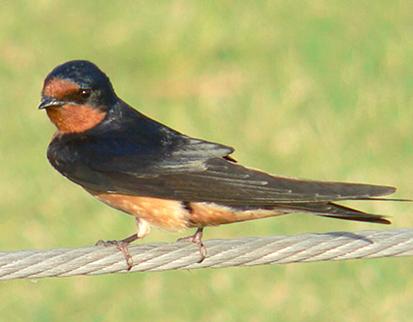Swallow - Barn
Scientific Name: Hirundo rustica
Tue, 15th July, 2025 - 10:17 pm GMT
Sponsor Ads:

Alternative Name
Scientific Name: Hirundo rusticaBasic Info
One of the most distinctive features of the Barn Swallow is its tail, which is long and deeply forked. Most of the upper parts of the bird are a beautiful iridescent blue color. The tail and wings are black, tinted with a green or blue gloss. Generally, the throat, chin, and forehead of the barn swallow are a maroon or chestnut brown. The underside of the Barn Swallow and the breast are usually a lighter tan or cinnamon color, and the tail has white patches underneath. A broken band runs over the breast, and is usually blue in color. Immature Barn Swallows have shorter tails and more whitish undersides than adult birds. At maturity, these birds measure between 15 and 19 centimeters long.
Health
Barn Swallows are quite hardy and adaptable, but if you allow one to stay in your area, you must be prepared for more! Often, these sociable birds live in colonies! Breeding Both male and female Barn Swallows participate in nest building. Usually, a clutch consists of four to six white brown- speckled eggs. Nesting begins in May, and often two clutches are raised in a year.Habitat
N/ABehavior
Although man-made structures frequently displace wildlife and destroy their habitats, the Barn Swallow may actually benefit from such building. These birds live in a variety of structures built by humans, from bridges to barns! Barn Swallows often live in groups. Generally, about seven pairs of birds will make their nests in a single barn; although up to 25 pairs have been reported! The Barn Swallow builds its nest from mud and straw, forming the mud into a small lump that it carries in its beak to the nesting site. The nests are lined with feathers. Although Barn Swallows are most commonly found in barns, they will nest in all sorts of buildings and have even been reported to build nests on boats! They have adapted very well to human invasion of their territory, taking full advantage of bridges, wharves, mine shafts, and other structures. Before such structures were in place, Barn Swallows built nests in rocky cliff crevices, although today, such nests are rather uncommon. Barn Swallows usually eat insects, which they catch in mid-flight. When they fly in groups, they can be seen darting back and forth and are quite acrobatic! Each year, Barn Swallows abandon their nests to migrate south for the winter. Although they may not return to the same nesting site, many do. Most birds breed within 20 miles of the nesting area where they were hatched.Origin
North AmericaHistory
Barn Swallows generally live in North America in summer months and migrate down through Central and South America in the cold seasons. Unlike many other bird populations, the number of Barn Swallows has actually increased in the 20th century as the birds have adapted quite well to the destruction of their habitats by simply creating a new manner of living. Barn Swallows make useful inhabitants in a barn; they eat pests such as flies and mosquitoes!Common Foods
N/ASponsor Ads:
It is difficult to get a man to understand something when his salary depends upon his not understanding it. -- Upton Sinclair
Swallow - Barn
Coded by: BGID® | ALL RIGHTS RESERVED Copyright © 2000-2025
Disclaimer | Privacy | Report Errors / Contact | Credits








 President of the United States of America - Real Estate mogul, Pageant owner and now one of the most controversial men in political history.
President of the United States of America - Real Estate mogul, Pageant owner and now one of the most controversial men in political history.  Global warming has been in and out as the "latest" hot topic for many years. It is, according to modern scientists, the result of man-made industrial pollutants, clearing forested areas, agriculture, etc. But now they are thinking it started way before the Industrial Revolution...
Global warming has been in and out as the "latest" hot topic for many years. It is, according to modern scientists, the result of man-made industrial pollutants, clearing forested areas, agriculture, etc. But now they are thinking it started way before the Industrial Revolution...  Politician, US Vice President and President of the USA - Joseph Robinette Biden Jr.
Politician, US Vice President and President of the USA - Joseph Robinette Biden Jr.  versus
versus  Russia: 'The Evil Empire'? Are they all that bad or is it just the USA trying to portray Russia as bad because they are a world power with land bigger and a society very different from the USA ideal?
Russia: 'The Evil Empire'? Are they all that bad or is it just the USA trying to portray Russia as bad because they are a world power with land bigger and a society very different from the USA ideal? 
 Corona virus
Corona virus 
 Users with wide screen monitors can benefit from more content on every page.
Users with wide screen monitors can benefit from more content on every page.